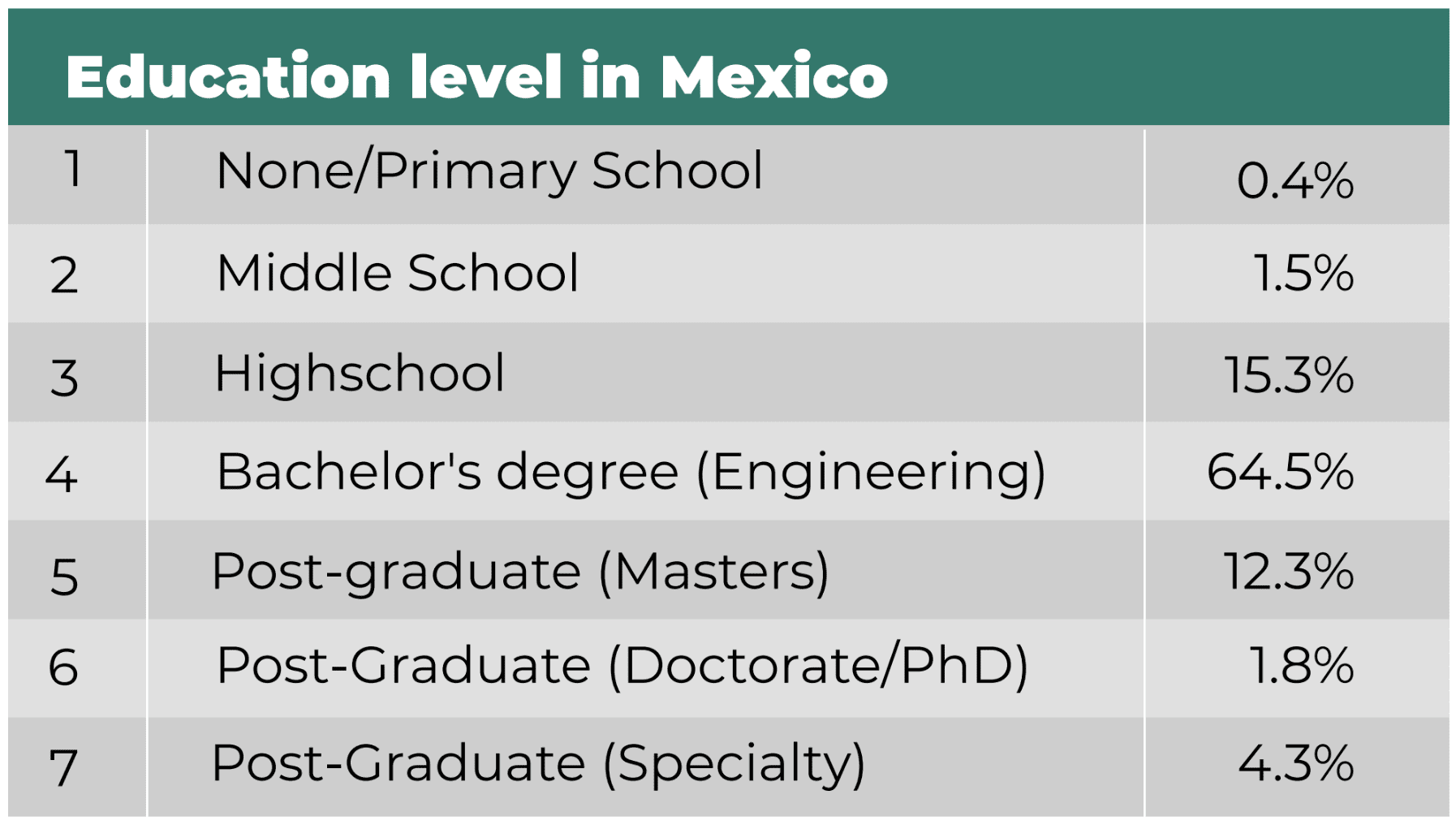
Nearshore software development in Mexico is a growing phenomenon.
There are a couple of reasons for this.
Nearshoring has gained traction as a growth strategy because it helps companies grow without too much overhead cost or risk. Mexico has also adopted remote work, which makes hiring remote talent easier.
A Short History of Nearshoring to Mexico
Nearshoring is a subcategory of offshoring. The main difference is the geographic distance and location along with other factors like culture and language. In the past, offshoring was attributed to companies setting up some or part of their operations overseas in places like China and India. Nearshoring emphasizes geographical distance as an advantage and therefore refers to when companies outsource to nearby countries for cost or other reasons.
Nearshoring to Mexico increased about 30 years ago when the three North American countries signed the original NAFTA agreement. Mexico became a preferred location for global companies to install factories and manufacturing centers. And while nearshoring is often associated with the manufacturing and automotive industries, it has—in recent years— become the go-to destination for tech companies looking to expand their global and remote teams in the LATAM region.
Because of its unique geographical and cultural positioning, Mexico serves as the gateway to the rest of Latin America, which in recent years has caught the eyes of investors and companies that see the growth potential fomenting in the region. Mexico offers U.S. companies, for example, distinct advantages such as reduced cultural barriers, similar time zones, and linguistic similarities (many Mexican professionals speak fluent English).
What is Nearshore Software Development?
When it comes to the tech industry, Mexico has a lot to offer. Nearshore software development refers to companies that hire talent in nearshore destinations like Mexico to help, enhance, or lead their software development efforts.
Why is Mexico a Good Nearshoring Destination?
The main component of nearshoring is geographic distance. By that measure alone, Mexico is a top destination for U.S. companies because of its geographic proximity, which translates into shared time zones, easy access and travel via land and airplane, and cultural similarities and cultural ties between the two countries.
High Rates of Education
When nearshoring software development, education is a major consideration for many companies. Mexico’s government has encouraged tech education throughout the country through various programs, universities, apprenticeship programs, and so on. According to CodersLink surveys and research, a majority of Mexico’s tech professionals have at least a Bachelor’s Degree in Engineering.

High Rates of English Proficiency
In recent years, Mexico has put a lot of emphasis on its English education. Most students pursuing a university degree will have some level of English education.
According to CodersLink own data from 2023, the English proficiency rate among tech professionals is as follows:
| Fully Bilingual | 14.5% |
| Basic | 13.7% |
| Advanced | 32.9% |
| Intermediate | 36.5% |
| None of the above | 2.4% |
Our survey showed that almost half (47.4%) of working tech professionals will have an advanced or higher English level.
Simplified U.S. Mexico Collaboration
Collaboration between the U.S. and Mexico is common thanks to several factors.
- Trade Agreements: Friendly relations and trade agreements facilitate business between the two nations. Agreements such as the USMCA provide added protections and freedoms when it comes to companies doing business across borders.
- Cultural Similarities: At the same time, cultural similarities make collaboration between the two nations easier than when dealing with a distant and different culture like China or India. Our recent post about the Mexico Tech Ecosystem talks about the workplace culture in Mexico and how it relates and overlaps with the U.S.
For example, Mexico values hard work and a strong ethic in the workplace. Like other countries in Latin America, there is great emphasis on personal relationships within business culture. The software development community in Mexico values feedback, strong communication when collaborating, and an engaging work environment.
- Shared Time Zones: The overlapping time zones is part of what makes nearshoring so popular. International tech teams now recognize the added advantages that come with sharing time zones when it comes to collaborative software development. Overlapping time zones also make agile development easier. For companies that use the Agile process for product and project development, the real-time collaboration possible with Mexican developers is a competitive advantage.
Vibrant Tech Ecosystem
A tech ecosystem is a self-feeding community and network of tech professionals, entrepreneurship, and technology innovation. Generally speaking, a tech ecosystem is made up of educational institutions, tech professionals, companies, entrepreneurial activity, technology parks, research, digital nomads, and more.
In recent years, Mexico has seen the rise of several startups into big markets and even reached unicorn status. Some of the biggest companies in Mexico include those such as:
- Bitso
- Clara
- Clip
- Kavak
- Konfio
- Merama
In addition to startups and small companies using technology to provide solutions, research in technology parks contributes to a lot of the tech ecosystem. There are over 37 technology parks in Mexico surrounding major universities or high-activity centers. These include:
- Creative Digital City
- Scientific and Technology Park in Zapopan Jalisco
- Apodaca Technology Park
- Monterrey Technology Park
- Guadalajara Software Center
Tech education has played an essential role in the expansion and enhancement of the Mexico tech ecosystem. Some of the most well-known universities and tech education institutions include:
- Tecnologico de Monterrey
- University of Guadalajara
- Universidad Autónoma de Nuevo León
- Universidad Nacional autonoma de Mexico
- Instituto Politécnico Nacional de México
The Mexican government, both at the federal and state level, has initiated efforts to encourage and help entrepreneurs and small businesses through initiatives like the National Entrepreneur Fund.
In recent years, there has also been some strong VC investment in Mexico. Many investors saw Latin America as a growing region full of potential and focused their efforts in some of the exciting growth that happened post covid. In 2021, Latin America became the fastest-growing region for VC investment. As outlined by Crunchbase, that trend has held steady to some degree in Mexico.

Source: Crunchbase
Large Developer Pool
In recent years, LATAM has been a growing region for tech professionals, especially software developers and engineers. Thanks to the interest in studying technology, many students go on to pursue computer science degrees and focus on software development, as well as studying English.
According to Bloomberg Linea, Mexico is second only to Brazil when it comes to the number of working software developers. Some estimates say that tech professionals reach at least 700,000.
| Country | Pool of Software Developers |
| Brazil | 500,000 |
| Mexico | 326,000 |
| Argentina | 115,000 |
| Colombia | 62,000 |
| Chile | 61,000 |
The Established Tech Presence in Mexico
Mexico is also home to several growing tech hubs. Cities like Mexico City, Guadalajara, Merida, and Monterrey, seem to be regional hubs where much of the tech ecosystem stems from. While the cities have a higher concentration of talent, the country has really moved to a remote-first model, where many developers prefer and/or choose to work from home.
Tech companies with an established presence in Mexico:
- IBM
- Amazon
- HP
- Dell
- Oracle
- Intell
- Freescale
- Tata
- Wipro
- HCL
- Luxoft
- Ooyala
- Wizeline
- Freescale
- Flextronics
- Jabil
- Gameloft
- Toshiba
- Cisco
- Microsoft
A Robust Software Industry in the Country
The numbers also show that Mexico has a strong software industry. According to Statista, the revenue for the software industry in the country is steadily increasing and has an impressive value of 2.2 million U.S. dollars in the area of Enterprise Software.
Find Elite Tech Talent and Nearshore Software Development to Mexico
In today’s remote-first world, companies are finding that building remote tech teams opens up possibilities. Not only does it offer lower cost options for hiring specialized tech positions, but it allows for diverse teams and unique perspectives. The best way to reap the full potential of a talent market is by working with a trusted partner that knows the region in various capacities.
CodersLink provides unmatched market intelligence and guidance to help educate companies on how to hire the best talent in LATAM. With a community of 25,000+ developers, engineers, and other vetted tech professionals, we help build world-class teams.
Ready to find your all-star tech team right next door? Talk to one of our team members.


